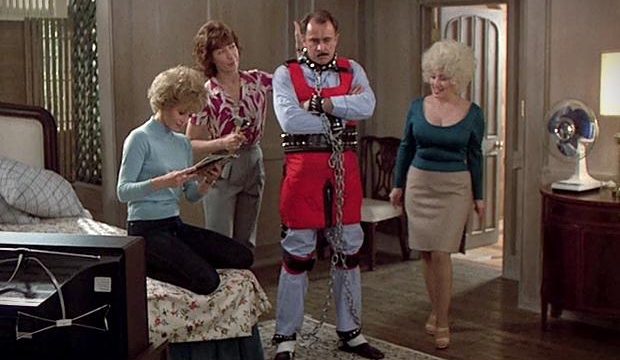I first stumbled across Nine to Five when I was a tween staying at a hotel with my parents who were momentarily out of the room. It was one of the scenes when Dabney Coleman’s abhorrent boss, Hart, is being held hostage at Judy’s house, trapped in bed by an elaborately constructed restraint system. Scandalized, I was sure whatever movie this was must have involved S&M and changed the channel before my sex-negative mother could catch me watching such a thing.
Imagine my surprise when my mother showed me the very same movie just a few years later, hailing it as a can’t-miss feminist classic. Dabney Coleman looked familiar the entire movie, but I was surprised to discover there was nothing sexually humiliating about the restraints the ladies used to contain him. Like everything this trio of gal pals pull off in Nine to Five, practicality took precedent over ego.
Dolly Parton steals Nine to Five as Doralee, which seems right since the movie was launched as her acting debut as the other talents it boasted had proven themselves in previous roles. Doralee is so smart and funny in this, proving a feminine look doesn’t dictate a gal’s chutzpah. If this character couldn’t hold her own under some pretty intense harassment, a lot of this movie’s joy would be defused, but Parton is such a spitfire that you know she can hold her own and it works. Lily Tomlin is as sarcastic, put-upon, and talented as Violet, constantly being passed over for promotions. I’m sorry to say that Jane Fonda’s Judy comes off a little bland in comparison to her two companions just because someone’s gotta play straight man. That Nine to Five is told through Judy’s perspective seems like the film trying to overcompensate for making her a bit of a cypher. Dabney Coleman is over-the-top in the best way as the despicable Franklin Hart, who takes advantage of Doralee, sexually, and Violet, professionally.
One of the things that sets Nine to Five apart from its well-meaning feminist contemporaries like Working Girl is that Nine to Five doesn’t revolve around a guy or a romance. It actually offers concrete, practical policies like flexible scheduling, equal pay for equal work, a job sharing program, and an on-sight daycare center that real workplaces instituted and still are instituting to make their workplaces more woman friendly. The women have no problem pretending Hart made these changes as they institute them in his absence. They’re just happy things improved. In fact, the whole office is happy about it. So happy about it that the company’s chair, Russell Tinsworthy, stops by to compliment Hart on how much productivity has increased. Notably Tinsworthy is happy with all the new programs except for the equal pay for equal work between genders one which is a nice little biting piece of commentary about how men prioritize power signifiers.
A while back, we had a thread in The Dissolve about what movies people wouldn’t have seen without the recommendation from another Dissolver. I was surprised how many men told me that they only watched Nine to Five at my recommendation and how different it was from how they imagined it would be. Many said they imagined it would be more serious. (Several men specifically mentioned that they did not expect to see a rodeo fantasy sequence in a feminist masterpiece.) I was surprised to be so closely associated with Nine to Five, a movie I like very much, but wouldn’t list it on my Top 100 favorite films of all time. Due to the entirely male gender breakdown of the Dissolvers who said I convinced them to watch it, I have to assume that mothers are not showing Nine to Five to their sons the way that my mother did to me, and that’s a damn shame! Sit the whole family down for this fun feminist comedy ASAP. We all just might learn something.
This is cross-posted with Movie of the Week for the Dissolve Facebook group!

